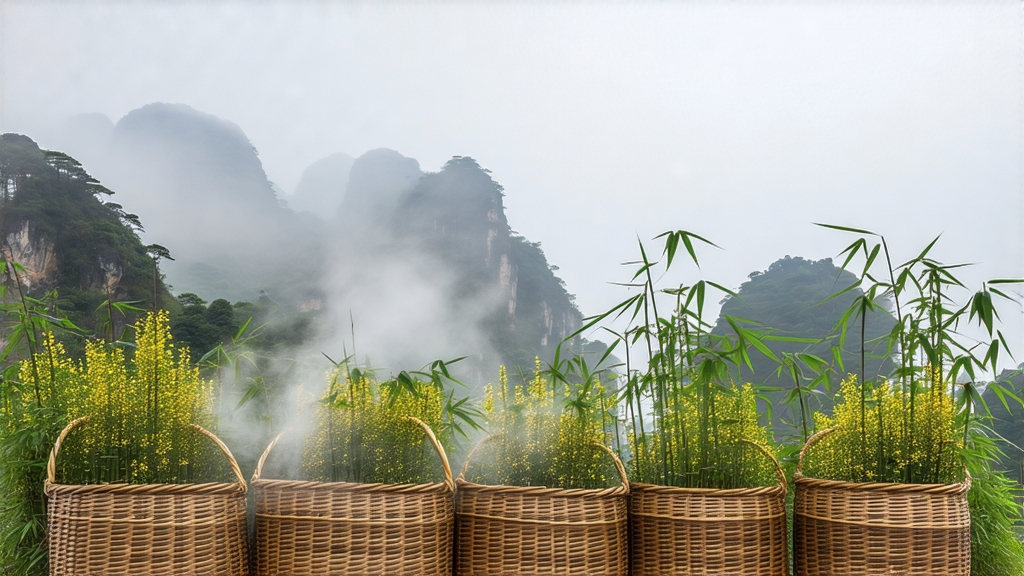
Tucked high in the mist-veiled Dabie Mountains of western Anhui Province, a tea once reserved for emperors quietly survives the rush of modern commerce. Huoshan Huangya—literally “Yellow Buds of Huoshan”—is the least-known member of China’s six great tea families, yet it carries the most enigmatic processing secret: the “menhuang” or “sealed yellowing” step that suspends green tea’s grassy vigor and ushers in a mellow, orchid-sweet complexity unknown to any other leaf. To understand this fading treasure is to glimpse the Song-dynasty court, the Ming-era caravan trails, and the microscopic choreography of enzymes that still refuse to be rushed.
History: from mountain herb to tribute tablet
Local gazetteers record wild tea gathering in Huoshan as early as 220 BCE, but the first written tribute order appears in 1043 CE when Emperor Renzong of Song accepted “Huozhou yellow tablets” as tax. The leaf’s golden color—achieved accidentally when spring caravans were delayed by rain—so delighted the palace that prefectural officials began replicating the mellowing effect on purpose. By the Ming dynasty the tea had evolved into the slender, down-covered buds we recognize today; Qing records list it alongside Longjing and Junshan Yinzhen as one of three teas permitted at the Altar of Heaven. Revolution, war and the rise of green-tea export markets pushed Huoshan Huangya to the brink of extinction; in 1972 only two elderly masters still remembered the full yellowing protocol. A state-sponsored restoration project in 1979 rescued seed gardens and re-established the slow craft, yet annual production remains below 3000 kg—rarer than silver in the age of stainless steel.
Terroir: why the Dabie Mountains taste like orchid milk
Huoshan county straddles 31° N at elevations of 300–800 m where the Dabie range funnels humid air from the Yangtze valley into sudden nightly fogs. The temperature swing—often 15 °C between noon and dawn—forces the tea bush to thicken its cell walls, concentrating amino acids such as theanine. Soils are quartz-rich yellow granite loam, acidic (pH 4.8–5.3) and laced with slow-release potassium, giving the leaf a signature “orchid-milk” aroma impossible to replicate in nearby counties. Only three micro-valleys—Jinji Mountain, Foziling Reservoir and Sunjiawan—are officially recognized for authentic Huoshan Huangya, and the picking window is cruelly short: the first bud-and-immediate-leaf set must be plucked before Qingming festival, usually less than ten days.
Varietal architecture: one name, two styles
Purists divide Huoshan Huangya into two stylistic expressions that share the same cultivar but diverge in finishing.
- Huoshan Huangya Jinya (Golden Bud): buds alone, 1.5–2 cm long, pan-fired at 120 °C then yellowed for 72 hours; liquor glows like pale sherry.
- Huoshan Huangya Yinya (Silver Bud): one bud and one unfolded leaf, fired at a cooler 100 °C and yellowed 48 hours; the leaf edge keeps a moss-green hue while the vein turns ochre, yielding a more mineral, bamboo-shoot cup.
Both styles must contain at least 85 % buds to meet the 2020 Anhui provincial standard DB34/T 3656.
Craft: the art of letting the leaf suffocate gently
The processing choreography—still done entirely by hand for top grades—spans five days and is best understood as a slow-motion negotiation between moisture, oxygen and temperature.
- Qingcao (kill-green): 3–4 minutes in a 120 °C bamboo wok, enough to halt oxidative enzymes yet preserve 8–10 % internal moisture.
- Menhuang (sealed yellowing): the pivotal step. The warm leaf is piled 8 cm deep inside oak barrels lined with wet linen; the barrel is sealed and kept at 28–30 °C for 60–75 hours. During this suffocation phase chlorophyll breaks into pheophytin, catechins dimerize into theaflavins, and a hay-like aroma mellows into orchid custard. Masters judge readiness by sound: when the rustle of tossed leaves softens to a hushed “